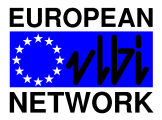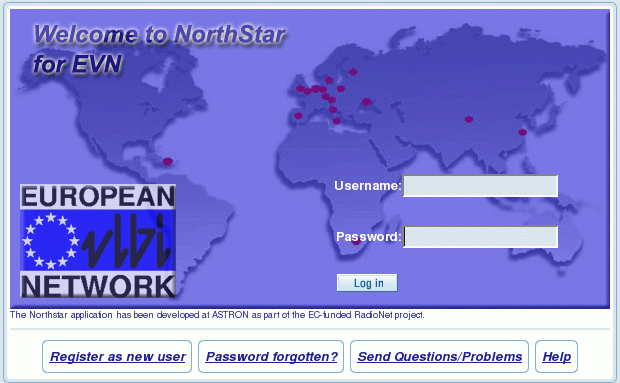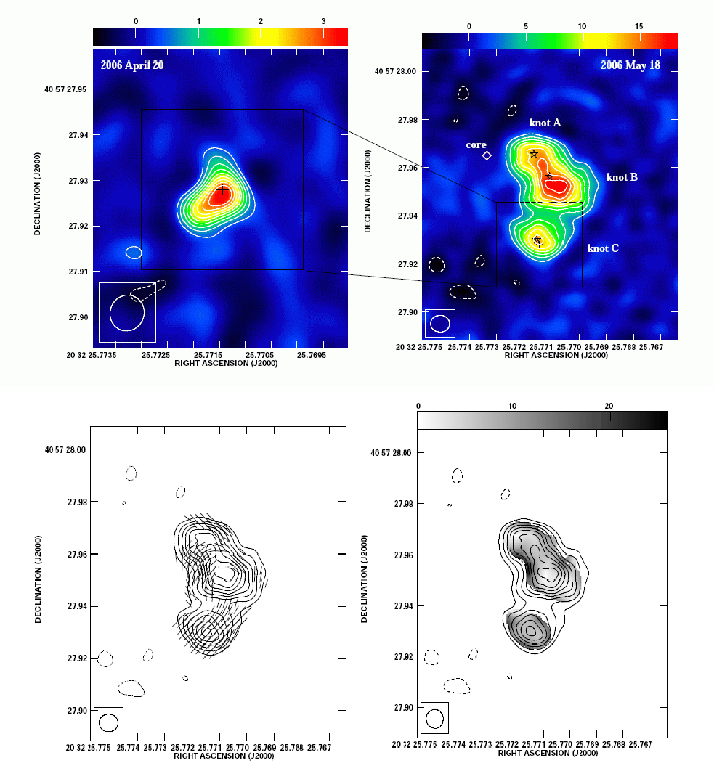 |
European VLBI Network
Newsletter
Number 16
January 2007 |
1. Call for
Proposals - Deadline 1 February 2007
Detailed
Call for Proposals
Observing proposals are invited
for the
EVN, a VLBI network of radio telescopes spread throughout Europe
and beyond, operated by an international Consortium of institutes.
The EVN is open to all
astronomers. Use of the Network by astronomers not specialised in the
VLBI technique is encouraged.
The Joint Institute for VLBI in Europe (JIVE)
can provide
support and advice on project preparation, scheduling,
correlation and analysis.
EVN Observing Sessions in 2007
| 2007 Session 1 |
Mar 01 - Mar 22 |
18/21cm, 6cm, 5cm, 1.3cm |
| 2007 Session 2 |
May 31 - Jun 20 |
18/21cm, 6cm, 5cm, S/X |
(likely observing wavelengths) |
| 2007 Session 3 |
May 31 - Jun 20 |
18/21cm, 6cm, 5cm, 7mm |
(likely observing wavelengths) |
Proposals received by 1 February
2007 will be considered for scheduling in
Session 2, 2007 or later. Finalisation of the planned observing
wavelengths will depend on proposal pressure. Other wavelengths which
may be scheduled in 2007 are 90cm, 50cm and 30cm.
Special features for Sessions
in 2007
- Proposals at 7 mm are
encouraged as this frequency is likely to be available in Session
3/2007.
- Recording at 1 Gb/s (Mark
5A) is now possible for an increasing number of projects. It is planned
that this will become soon the standard observing mode for all
continuum EVN-only projects.
- MERLIN is now available for
joint EVN+MERLIN observations in all sessions, for any EVN wavelengths
which MERLIN supports (18/21cm, 6/5cm, 1.3cm). However, limited
resources during e-MERLIN construction mean that joint EVN+MERLIN will
be scheduled at no more than two of these bands (usually 18/21cm and
5/6cm) in any one session.
Large projects
Most proposals request 12-48hrs
observing time. The EVN Program Committee (PC) also encourages larger
projects (>48 hrs); these will be subject to more detailed scrutiny,
and the EVN PC may, in some cases, attach conditions on the release of
the data.
How to submit
The on-line proposal submission tool
Northstar now replaces the old Latex-email way of submission for
all EVN proposals. It is therefore also available to submit Global
proposals; Northstar Global proposals will be forwarded to NRAO
automatically.
To use Northstar, people should
register (only for the first
proposal submission), complete technical information on-line
(equivalent to that previously in the coversheet), and upload a
scientific justification in pdf or ps format. The scientific
justification should be limited to 2 pages in length. Up to 2
additional pages with diagrams may be included. The deadline for
submission is 23:59:59 UTC on 1 Feb 2007.
NorthStar will be opened up for
preparation of proposals starting on 18 January 2007. A separate text
with more detailed instructions will be distributed over the VLBI
exploder, and placed on the usual webpages.
Although in this startup phase
the EVN will also accept the old style of submission, the use of this
route is likely to be discontinued for EVN proposals in the near
future, and EVN proposers should make the switch now. See the
detailed Call for Proposals for further information.
Additional information
The detailed
Call for Proposals has further information on Global VLBI,
EVN+MERLIN and guidelines for proposal submission.
The EVN User Guide
describes the network and provides general information on its
capabilities.
The EVN Status Table
gives current antenna capabilities.
The On-line VLBI
catalogue lists sources observed by the EVN and Global VLBI.
2. NorthStar: A Web-based Proposal Tool for
the EVN.
This January,
the EVN joined a growing number of observatories in adopting a version
of the NorthStar proposal tool for submitting proposals to the EVN
programme committee. NorthStar is already being used by Westerbork,
MERLIN and the JCMT, with Effelsberg and others, including optical/IR
telescopes, soon to follow. NorthStar will completely replace the old
LaTeX/email system for EVN proposals (and can also be used for Globals)
and will be used for the first time for the 1 February 2007 proposal
deadline. The tool and accompanying help files can be found at
"http://proposal.jive.nl".

NorthStar
provides significant improvements for EVN users, the EVN program
committee and for operations staff. For EVN users it will provide a
simplified interface to provide the information contained on the old
coversheet. Also, the large number of observatories who have adopted,
or plan to adopt, versions of NorthStar means that users will only have
to deal with a single interface to submit proposals to a number of
telescopes.
In addition to
the benefits it will bring to EVN users, NorthStar will also store EVN
user and proposal information in a secure database, simplifying
administration for the EVN PC and for EVN operations. Ultimately
NorthStar could form part of a beginning-to-end system that will track
all projects from the proposal stage through review, scheduling and
archiving to final publication.
To use
NorthStar, users must first register. Following registration, NorthStar
will email users a password (which can later be changed). Registration
is only required once and takes only takes a few minutes. All potential
EVN users are encouraged to register early and explore the new tool in
advance of the upcoming proposal deadline.
Acknowledgements.
NorthStar has
been developed as an activity in the EU-funded RadioNet Synergy
project. The overall design and building of the common infrastructure
were carried out at, and partly funded by, ASTRON, principally by Hanno
Holties, Anton Smit, Bastiaan Verhoef and Rene Vermeulen. Over the last
several months, the parts specific to the EVN module have been
developed principally by Bauke Kramer (JIVE), Hanno Holties and Anton
Smit (ASTRON). The process was guided by an EVN working group headed by
Rene Vermeulen (ASTRON); consultations with NRAO took place via Joan
Wrobel. Pre-release testing was carried out by many people including
the EVN PC and JIVE support staff.
Cormac Reynolds.
3. Changes in
Dwingeloo
On February 1
Mike Garrett leaves JIVE to take on the position of General director of
ASTRON. Mike started at JIVE in 1996, giving shape to the EVN support
and leading the EVN TOG. The success of his directorship over
the past 4 years can be measured by the growth of the institute from 20 to
almost 40 people. A large fraction of these numbers originate
from EC projects like the e-VLBI initiative EXPReS, for which Mike was
the coordinator. As the director of ASTRON, Mike will remain close to the
focus of the European VLBI Network.
The JIVE board
has decided to advertise the position of JIVE director and the
advertisement will shortly be distributed widely. In the transition period
Huib van Langevelde has accepted the responsibility of interim director.
In this function he will take over the various roles Mike Garrett
is playing in the EVN, RadioNet and other directing bodies. The JIVE
staff is currently redistributing some responsibilities in
order to deal with the interim period. On the agenda for the next
couple of months are the evaluation of RadioNet and EXPReS and the
establishment of a new MOU for JIVE. On behalf of all the EVN and its
users, the JIVE board likes to express its support to the JIVE
management in these interesting times. We thank Mike in particular for his contributions to
JIVE and teh European VLBI Network. We also thank Huib for his
willingness to serve as interim director.
On behalf of the
JIVE board, Prof. Anton Zensus (chair)
4. e-VLBI Comes of Age: First publications of
e-VLBI
science papers
The first papers
resulting from e-VLBI science observations have been
accepted for publication in the Monthly Notices of the Royal
Astronomical Society (MNRAS). Other papers have been published as
conference proceedings, but this first publication of letters in a
refereed journal is a milestone of maturity for e-VLBI. The first
paper, "First e-VLBI observations of GRS 1915+105", by
Rushton et al., was published in the January 2007 issue of MNRAS. The
second paper, "First e-VLBI observations of Cygnus X-3", by Tudose et
al., is expected to be published in the February 2007 issue.
The two papers both discuss data taken within the first open call for
observations available to the whole scientific community using the six
current EVN telescopes: Cambridge (UK), Jodrell Bank MkII (UK),
Medicina
(Italy), Onsala-20m (Sweden), Torun (Poland) and Westerbork (The
Netherlands). Data was sent from each of the participating telescopes
at
a sustained data rate of 128 Mbps to the EVN correlator at JIVE (The
Netherlands).
For more information on the detailed scientific results, see the
astrophysics preprint server: http://arXiv.org/abs/astro-ph/0611054
and
http://arXiv.org/abs/astro-ph/0611049.

The Tudose et al. observations captured the
X-ray binary system Cygnus X-3, both in quiescence (April 2006) and
during a huge, active outburst (May 2006). The total intensity and (the
very first VLBI) polarisation images are shown.
Kristine Yun - EXPReS Public Outreach Officer
2006 Session 3: 23 -
29 November
Wavelengths:
6cm 3.6cm
This session was later than originally planned, due to delays in the work to replace the
subreflector of the Effelsberg telescope. The session was
moved to as late in the year as possible, subject to a number of observing
constraints (many of the telescopes already had IVS
committments). The plan was to schedule just those wavelengths observable using the
secondary focus in Effelsberg, since operation from the prime focus
would not be possible until January 2007. This included user
observations at 1.3cm (1), 3.6cm (1) and 6cm (6).
Unfortunately,
problems with the azimuth track at Seshan (Shanghai) meant that it
could not participate in the session; in addition the Nanshan (Urumqi)
1.3cm receiver had broken. These further restrictions reduced the
session to just two 6cm observations and one 3.6cm observation (a
global). The spare time made available was used to schedule a
special 24-hour amplitude calibration investigation, lead by D. Graham.
As EVN users
know, proposals are judged by the EVN Program Committee about 1 month
after the advertized deadlines, and receive either a numerical grade,
a rejection, or a recommendation for resubmission. Those with a
grade are considered "eligible for scheduling", with a priority
indicated by the grade (low number is high priority). The Scheduler's task
is to get these scheduled as soon as feasible (unless, of
course, the proposer or the EVNPC has stipulated a delay in scheduling
for scientific reasons).
The timing of
the 3 observing sessions per year allows, in principle, any project to
be scheduled within roughly 4 months of submission. Unfortunately,
there are many constraints which mean that this is not possible for
many projects. The most common are:
A) requested
frequency cannot be run in the "next" session. The EVN is not
"frequency-agile" and for logistical reasons there is a limit of 4 on the
number of frequency bands which can be run in a single session. Which
bands are actually scheduled is the result of a mixture of the need to
plan some bands in advance because of observatory constraints, and
the "proposal pressure" at each band.
B) some key
element of the observation may not be available. This is commonly MERLIN
(although this reason should disappear in the near future), but
sometimes the GBT or Arecibo, since time there is not reserved for the
whole session in advance and there may be scheduling conflicts. And
of course, there may be crucial EVN telescopes which for some special
reason cannot take part, as in the last session.
C) limit of
resources for the session. In the past this has frequently been the
recording capacity (not enough tapes or TBytes of disk space), but it
can also be not enough observing time; sessions last for a maximum of
3 weeks, which includes down time for receiver changes. In
fact, this limit most often appears in the form of "GST bunching" where
many different projects require the same GST observing slot. This
situation leads to rather inefficient filling of the available 24h
time periods.
The net result
is that eligible projects are often held over until the following
session (thus scheduled 8 months after submission) or even longer. There
are rules which govern how long a project may remain eligible before
is "expires" (or is superceded by a new proposal). Basically, a
project is allowed 2 chances to be scheduled in a session where its
frequency and telescopes are available, or lasts for one year, whichever
is longer. Recently an additional rule was introduced, giving an upper
limit of 2 years for any project which would otherwise have survived
for longer.
Some statistics
covering all proposals submitted since February 2002 (when the
present scheduler took over) are presented here. All numbers refer to
"observations" rather than proposals, since a single proposal may request
several frequencies or epochs.
There were 22
eligible observations (from 17 projects) which expired, after failing to
be scheduled due to their low grades (5 EVN-only with grades 1.7-2.0;
17 Global with combined "grade" 1.7-2.25).
Of 206 eligible
observations scheduled between June 2002 and March 2007 (excluding
2nd and subsequent observations of monitoring projects) the
percentage scheduled after 4 months was 56%, after 8 months 25% and
after 1 year 12% - only 7% took longer to be scheduled.
There is
obviously variation with requested frequency. For the 6cm band, which is
scheduled almost every session, the percentages scheduled after
4, 8 and 12 months are 63%, 21% and 13%. For the 5cm band, the
percentages are 48%, 31% and 21%.
Finally, there
has been some small improvement in the course of the last 5 years.
The percentages for all projects submitted before June 2004 are 50%,
24% and 13% - for those from June 2004 they are 62%, 25% and 11%.
Richard Porcas,
EVN Scheduler



